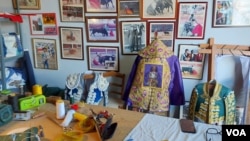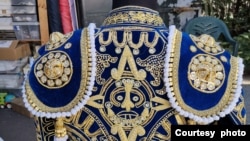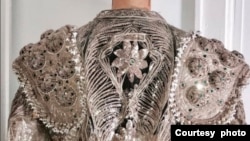When Enrique Vera opens the door to his workshop, an array of gleaming gold and silver matadors’ jackets shine in the sun.
“It is little bit like a cave full of treasure,” he says.
Vera painstakingly fashions the brilliant trajes de luces (suits of lights) which are worn by bullfighters when they face half-ton bulls in the ring.
One of only seven sastres (bullfighting tailors) in the world, he used to be a matador. But he swapped the sword used to kill the bull for a needle and followed a family tradition to become a tailor.
The iconic status of the matador’s suit has meant it has passed from the bullring to mainstream popular culture.
Vera and his mother, Nati, also a seamstress, were called on to make matadors suits for films and the catwalk, working with Pink Panther star Peter Sellers, designer John Paul Gaultier and the late ballet dancer Rudolf Nureyev.
From the moment a matador steps through the door into Vera’s office in Seville, southern Spain, it sets in motion an intricate process of measuring, sewing, ironing, and finally fitting the suits which can cost as much as $6,000 each.
Meticulous process
Vera’s team of 15 specialist seamstresses spend a-month-and-a-half making each suit, which is made to measure. Up to 300 drawings are made before a suit is finished.
The golden, blue or red jackets, trousers and capotes de paseo — the huge cape which the bullfighter carries when he emerges into the ring — are filled with rhinestones, beads and gold or silver thread.
One essential quality is all Vera’s suits must withstand bloodstains — from the bull or the matador.
“It is like drawing a work of art. You must capture the vision of the bullfighter for his suit, then make it a reality. It must be like a second skin,” Vera says in an office filled with photographs of famous bullfighters wearing his creations.
Ancient art dying?
But as attitudes toward bullfighting change in Spain, confecting these suits, whose design has remained the same for the past 150 years, is an art in decline.
Some Spaniards consider bullfighting to be an essential part of the culture, while others say it is a cruel spectacle.
In recent years, the number of bullfights has declined partly because of the pandemic, but also because Spaniards have a raft of different ways to amuse themselves and the animal rights movement is on the rise.
“The problem is that we have changed the concept of animals to humanize them. There is no one more environmentally conscious than breeders of fighting bulls,” Vera told VOA.
“The bulls spend three or four years living free. They are not being slaughtered for meat. But there are plenty of bullfights in Spain, Latin America, and France.”
He was not so sure, however, about his own job.
“There are less sastres because it takes a lot of time. The older ones are retiring and not being replaced,” he admitted. He hopes his 14-year-old son will follow him into the trade.
Polls show less support for bullfighting in recent years.
Some 46.7% of Spaniards were in favor of prohibiting bullfighting, while 18.6% backed the tradition and 34.7% had no opinion, according to a 2020 survey for Electomania, a polling company.
The number of bullfights fell from 1,553 in 2017 compared to 824 in 2021, according to government figures. Only 8% of the population attended bullfights in 2018-2019, compared to 45% who said they went to the theater or 70.3% who said they spent spare time reading.
The first bullfight in Spain was held in 711 A.D. in honor of King Alfonso VIII. Originally, the pastime was reserved for the nobility and took place on horseback. The present version of bullfighting started in Ronda at the start of the 19th century.
A bill to end bullfighting in France failed last year after a member of parliament withdrew the proposed legislation. Portugal allows fights where the bull does not die.
In Latin America, the tradition has been banned in some Mexican states, but is still legal in Peru, Colombia, Venezuela, Ecuador and Bolivia.
Tradition breaking
Paco Ramos, who runs www.trajesdeluces.com, which sells second-hand suits of lights, fears a younger generation of tailors may not emerge to replace the likes of Vera.
“For younger people it takes too long to make each suit and is too much work. But for now, there are not many tailors and there is enough demand,” he told VOA.
However, he was confident there was no chance bullfighting would be banned any time soon.
In 2013, the then conservative government introduced a law which declared bullfighting part of the national heritage which should be protected throughout Spain, effectively preventing any attempts to ban the practice.
Animal rights groups are planning to challenge the legal protection of bullfighting by introducing a bill through a people’s petition.
Marta Esteban, president of Torture Is Not Culture, an animal rights collective, told VOA she believed that public opinion was behind banning bullfighting.
“There is no doubt that it is coming to an end, but governments are not willing to give it a coup de grace,” she said.
Aldara Arias de Saavedra, a tour guide who grew up within the shadow of La Maestranza bullring in Seville, has never been to a bullfight.
“I can understand why some people like it. My father did. But it is not for me. You have to kind of grow up with it to be into it. It is like football, I suppose,” she told VOA.
Walk around the narrow streets near the bullring and there is a mini-economy which depends on this pastime, from bars to restaurants to those selling souvenirs like fake suits of lights.
“I think down here in the south, not everyone will go to bulls, but it is so associated with the big ferias and smaller ones in villages that it is not going to be banned soon,” said Marcos Alvarez, a cinematographer.













